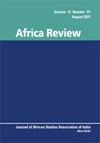Reflections on the ‘Zimbabwean crisis 2000–2008’ and the survival strategies: the sustainable livelihoods framework (SLF) analysis
IF 0.5
Q4 AREA STUDIES
引用次数: 9
Abstract
ABSTRACT In this paper, the author applies the Sustainable Livelihood Framework (SLF) to unravel the complexities inherent in the ‘Zimbabwean Crisis’. When unravelled from the SLF, the ‘Zimbabwean Crisis 2000-2008’ portrays a decimation of various forms of capital–financial, social, human, physical and natural–and forced Zimbabweans to innovate, show resourcefulness and ingenuity in generating various forms of capital to survive the scathing crisis. Broadly, the kukiya kiya strategy has received little scholarly study and despite various survival strategies inherent in the kukiya kiya strategy. The kukiya kiya livelihood strategy prominence is seen in its adoption across the broad spectrum of society–educated, uneducated, employed, and unemployed, women, and men, young and old. The study of kukiya kiya livelihood strategy is important because it sustained thousands of households as the Zimbabwean formal sector collapsed. This reality is largely unappreciated in literature.反思“2000-2008年津巴布韦危机”和生存战略:可持续生计框架(SLF)分析
在本文中,作者运用可持续生计框架(SLF)来揭示“津巴布韦危机”中固有的复杂性。从SLF中分离出来后,“2000-2008年津巴布韦危机”描绘了各种形式的资本-金融,社会,人力,物质和自然-的大量减少-迫使津巴布韦人创新,在创造各种形式的资本方面表现出足智多谋和独创性,以度过严峻的危机。总的来说,酷死屋策略得到的学术研究很少,尽管酷死屋策略中有各种固有的生存策略。kukiya kiya生计战略的重要性体现在其广泛的社会范围内——受过教育的、未受过教育的、就业的和失业的、女性和男性、年轻人和老年人。对kukiya kiya生计战略的研究很重要,因为在津巴布韦正规部门崩溃时,它支撑了成千上万的家庭。这一现实在文学中基本上没有得到重视。
本文章由计算机程序翻译,如有差异,请以英文原文为准。
求助全文
约1分钟内获得全文
求助全文
来源期刊

Africa Review
AREA STUDIES-
CiteScore
1.80
自引率
12.50%
发文量
22
期刊介绍:
Africa Review is an interdisciplinary academic journal of the African Studies Association of India (ASA India) and focuses on theoretical, historical, literary and developmental enquiries related to African affairs. The central aim of the journal is to promote a scholarly understanding of developments and change in Africa, publishing both original scholarship on developments in individual countries as well as comparative analyses examining the wider region. The journal serves the full spectrum of social science disciplinary communities, including anthropology, archaeology, history, law, sociology, demography, development studies, economics, education, gender studies, industrial relations, literature, politics and urban studies.
 求助内容:
求助内容: 应助结果提醒方式:
应助结果提醒方式:


